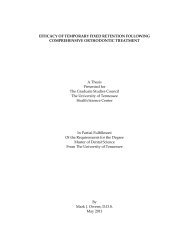BEVACIZUMAB EFFECT ON TOPOTECAN PHARMACOKINETICS ...
BEVACIZUMAB EFFECT ON TOPOTECAN PHARMACOKINETICS ...
BEVACIZUMAB EFFECT ON TOPOTECAN PHARMACOKINETICS ...
You also want an ePaper? Increase the reach of your titles
YUMPU automatically turns print PDFs into web optimized ePapers that Google loves.
1.6 Pharmacokinetic Models of TPT in Preclinical Studies<br />
Extensive preclinical pharmacokinetic studies for TPT have been published over<br />
the last 20 years [156-161]. Among these publications, numerous pharmacokinetic<br />
models either for in vitro intracellular TPT uptake and kinetics [156, 157] or for an in<br />
vivo pharmacokinetic model and effective schedule of TPT in human cancer xenografts<br />
[158-161] were proposed by several groups. Our discussion focuses mainly on TPT<br />
pharmacokinetic evaluation in preclinical animal models, including rodents and<br />
nonhuman primates.<br />
In order to better define the pharmacokinetic behavior of TPT in both plasma and<br />
cerebrospinal fluid (CSF) and to measure TPT CSF penetration, Blaney et al. [159]<br />
performed a pharmacokinetic study of TPT in 3 adult male rhesus monkeys after an<br />
intravenous dose of 10 mg/m 2 administered over 10 minutes and used a relative simplistic<br />
non-compartmental model to get the pharmacokinetic parameters. The CSF concentration<br />
peaked at 30 minutes after administration and the CSF penetration of TPT exceeded 30%,<br />
which warranted the further study in patients with high risk or refractory central nervous<br />
system tumors. In a more pharmacokinetically elegant analysis, Balthasar’s group from<br />
The State University of New York published two mathematical models of TPT in mice.<br />
The first one [158] described an integrated pharmacokinetic/toxicodynamic model to<br />
characterize the relationship between the TPT disposition and TPT induced toxicity.<br />
Body weight loss was used as the index of TPT-induced toxicity. The authors fitted four<br />
models composed of two disposition compartments and one peritoneal absorption<br />
compartment to the plasma concentration data, but with different kinetics of TPT<br />
absorption and elimination. A modified indirect response toxicity model was combined<br />
with the best fitting pharmacokinetic model selected from those four pharmacokinetic<br />
models. Four additional transit compartments were added to account for the delay of the<br />
time of maximum plasma TPT concentration and the time associated with the nadir body<br />
weight. The same group published a second paper regarding mathematical model of TPT<br />
in mice is a whole body physiologically based pharmacokinetic model to characterize and<br />
predict TPT concentrations in mouse plasma and tissues, such as lungs, heart, muscle,<br />
liver and brain [160].<br />
Moreover, tremendous work on the pharmacokinetic study and mathematical<br />
model of TPT has been published from our laboratory [162-166]. The traditional<br />
pharmacokinetic model used in the lab to describe the plasma and target tumor drug<br />
concentration used a non-linear three compartmental model including central<br />
compartment, peripheral compartment and tumor compartment. In this model, plasma<br />
TPT concentration–time profile was fit to a two-compartment model using a maximum a<br />
posteriori (MAP) Bayesian algorithm as implemented in ADAPT 5[162, 167-169]. With<br />
the plasma pharmacokinetic parameters remaining fixed, a third compartment was added<br />
to represent the tumor disposition of TPT and the parameters describing the TPT tumor<br />
concentrations were estimated for each study by using the maximum likelihood approach.<br />
17
















